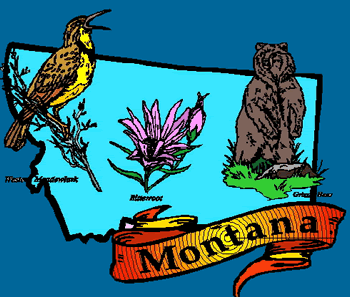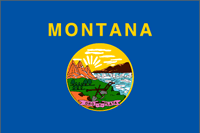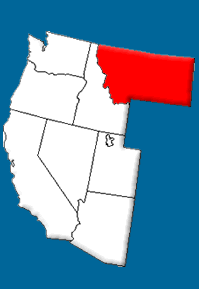 History:
The first white explorers to come to Montana were part of the Lewis and Clark expedition in 1804 through 1806. Soon after this group, however, came fur traders and trappers who were interested in the vast natural resources and trade with the Native Americans. Unfortunately, they also brought disease and alcohol to the Native people, and changed their economic system forever. Although the fur trade brought great change to the area, it was relatively short lived, dying out by the 1840s due to the over-hunting of beaver, and the loss of popularity of beaver pelts used for men's hats.
After the fur traders, the next group to come to Montana was Roman Catholic missionaries. They established St. Mary's Mission in the Bitterroot Valley, probably the first permanent white settlement in Montana. Along with their efforts to bring Christianity to the Native populations, they also promoted agriculture, and they built a sawmill for use in the lumber trade.
In the 1860s, gold was discovered in the area, and prospectors came in great numbers. Montana became a territory in 1864, and the influx of people coming to look for wealth led to the creation of "boomtowns." Unfortunately, when the gold ran out, these towns quickly declined.
The number of white settlers coming to Montana meant that the Native people lost access to their traditional hunting grounds. In the 1870s, trying to defend their territory, the Sioux and the Cheyenne defeated US troops at the Battle of Little Bighorn, and Chief Joseph and the Nez Perce Indians won a victory in the Big Hole Basin. In the long run, however, the Native Americans could not match the strength of the United States Army.
After the miners, the next group to settle Montana was cattle ranchers. There was a great demand for meat from the miners and other settlers, and the availability of free land to those who wanted to establish ranches made the enterprise profitable. The coming of the railroads in the 1880s also meant there was an easy way to ship meat to other parts of the country, further strengthening the ranchers' position in the state.
By 1889, Montana was admitted to the Union as the 41st state. Although the promise of gold had not been realized, Butte became famous when silver and copper were discovered. The Anaconda copper mine, owned by Marcus Daly, became one of the world's largest.
In 1909, the Enlarged Homestead Act brought more homesteaders to Montana for the availability of inexpensive land. The new settlers had success with wheat farming until the beginning of the 20th century when drought and changes in the market for grain ruined many farmers. |









